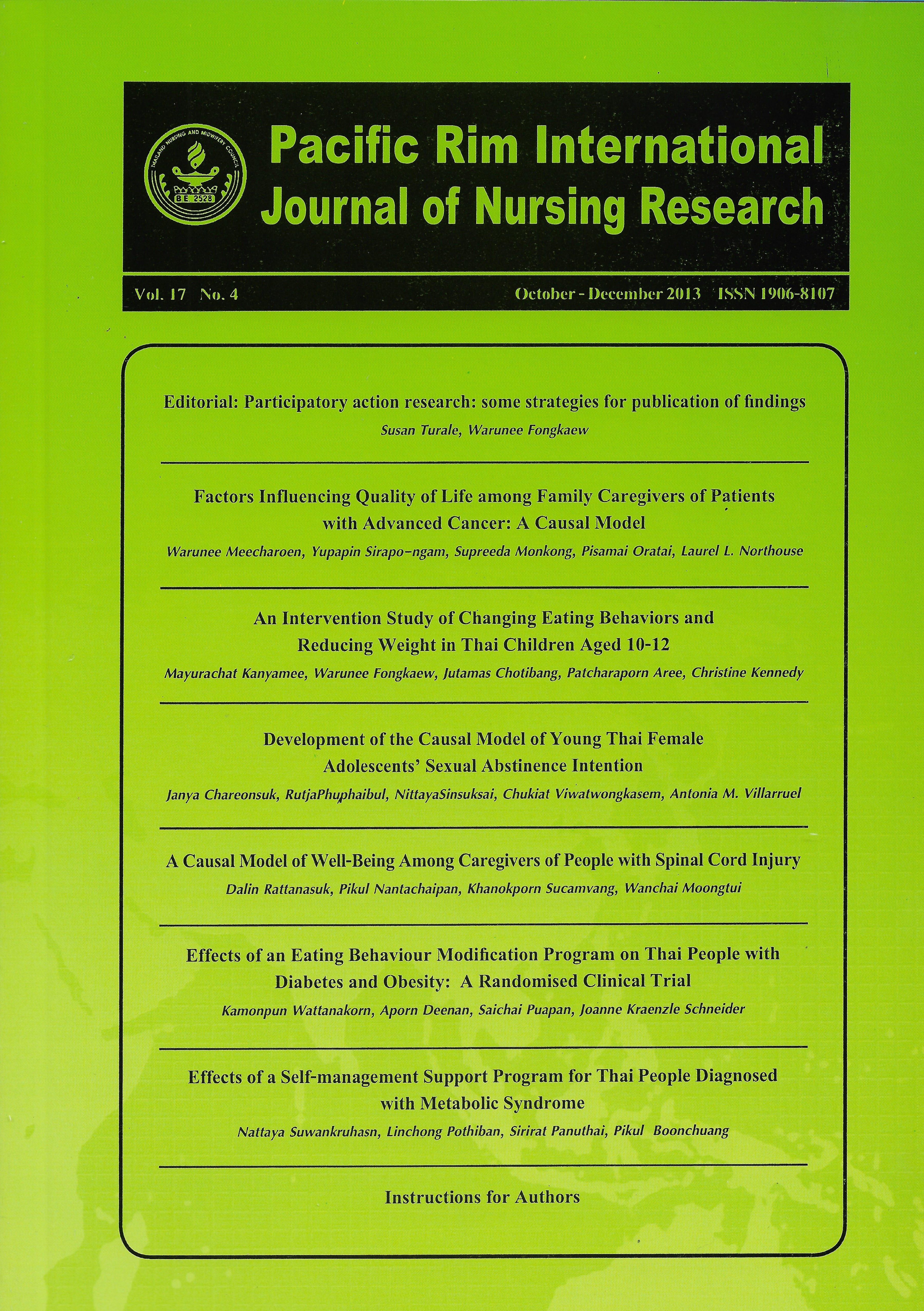Development of the Causal Model of Young Thai Female Adolescents’ Sexual Abstinence Intention
Keywords:
Females, Adolescents, Intention, Sexual abstinence, Parent-daughter communication, Theory of Planned BehaviorAbstract
The purpose of this cross-sectional descriptive study was to develop and test the causal model of the relationships among parent-daughter sexual abstinence communication, behavioral, normative, and control beliefs toward sexual abstinence to influence sexual abstinence intention. The sample consisted of 470 female Thai adolescents aged between 12-16 years in school grades 7-9 in Bangkok, Thailand. Data were collected by the Demographic Data Questionnaire, the Parent-Daughter Behavior Sexual Abstinence Communication Questionnaire, and the Sexual Abstinence Intention during the School Years Questionnaire.
Results indicated that our finalCausal Model of Young Thai Female Adolescents’ Sexual Abstinence Intentionfitted with the empirical dataandexplained 33% of the variance in sexual abstinence intention. Parent-daughter sexual abstinence communication had significant positive indirect effects on sexual abstinence intention through behavioral beliefs, normative beliefs, and control beliefs. Study findings can be used by nurses and others to design and test interventions to promote sexual abstinence during the school years among young Thai female adolescents. However, further testing of our Model is required in other populations and locations before findings can be generalized elsewhere.
บทคัดย่อ: การศึกษาครั้งนี้มีวัตถุประสงค์เพื่อพัฒนาและทดสอบความสัมพันธ์เชิงสาเหตุระหว่างตัวแปรการสื่อสารระหว่างพ่อแม่/ผู้ปกครองกับบุตรสาวเรื่องการละเว้นเพศสัมพันธ์ในวัยเรียน ความเชื่อเรื่องการละเว้นเพศสัมพันธ์ ความเชื่อต่อบรรทัดฐานทางสังคมและความเชื่อเรื่องความสามารถในการควบคุมพฤติกรรมการละเว้นเพศสัมพันธ์ ต่อความตั้งใจละเว้นเพศสัมพันธ์ในวัยเรียนกลุ่มตัวอย่างได้แก่วัยรุ่นหญิงไทยที่มีอายุระหว่าง 12-16 ปีและกำลังศึกษาอยู่ในชั้นมัธยมศึกษาปีที่1-3 ในเขตกรุงเทพมหานคร จำนวน 470 คน เก็บรวบรวมข้อมูลโดยใช้แบบสอบถามจำนวน 3 ชุด ได้แก่ แบบสอบถามข้อมูลส่วนบุคคลแบบสอบถามการสื่อสารระหว่างผู้ปกครองกับบุตรสาวเรื่องการละเว้นเพศสัมพันธ์ในวัยเรียน และ แบบสอบถามความตั้งใจในการละเว้นเพศสัมพันธ์ในวัยเรียน
ผลการศึกษาพบว่าโมเดลที่เสนอมีความสอดคล้องกับข้อมูลเชิงประจักษ์ โดยสามารถทำนายความผันแปรของความตั้งใจในการละเว้นเพศสัมพันธ์ในวัยเรียนได้ร้อยละ 33 ผลการศึกษาครั้งนี้บ่งชี้ว่าการสื่อสารของผู้ปกครองกับบุตรสาวเรื่องการละเว้นเพศสัมพันธ์ในวัยเรียนมีอิทธิพลทางอ้อมต่อความตั้งใจละเว้นเพศสัมพันธ์ในวัยเรียนของวัยรุ่นหญิงโดยส่งผ่านตัวแปรความเชื่อทั้ง 3 ด้าน ได้แก่ ความเชื่อเรื่องการละเว้นเพศสัมพันธ์ ความเชื่อต่อบรรทัดฐานทางสังคมและความเชื่อเรื่องความสามารถในการควบคุมพฤติกรรมการละเว้นเพศสัมพันธ์ ซึ่งผลการศึกษานี้พยาบาลและบุคคลอื่นสามารถนำไปใช้ทดสอบและวางแผนการพัฒนารูปแบบการส่งเสริมพฤติกรรมการละเว้นเพศสัมพันธ์ในวัยเรียนของวัยรุ่นหญิงไทย อย่างไรก็ตามควรมีการทำการทดสอบโมเดลซ้ำในกลุ่มประชากรอื่นและในที่ตั้งอื่นๆ ก่อนสรุปผลการนำไปใช้อ้างอิงถึงกลุ่มประชากรนั้น
Downloads
Published
How to Cite
Issue
Section
License
Copyright: The Pacific Rim International Journal of Nursing Research, Thailand Nursing & Midwifery Council has exclusive rights to publish, reproduce and distribute the manuscript and all contents therein.








.png)



